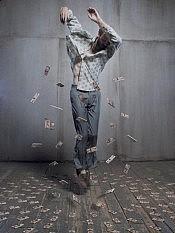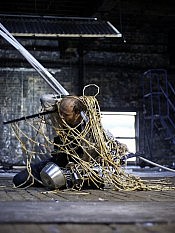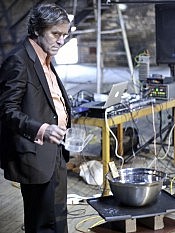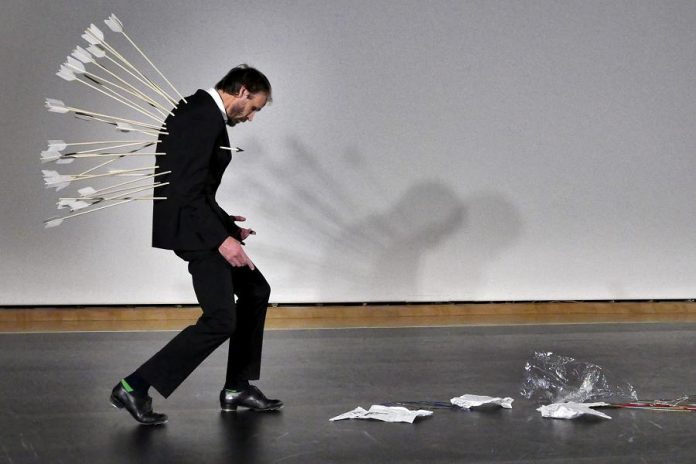
Public Energy, now in our 22nd year of bringing world-class dance to Peterborough, has recently been looking both to its past and its future, as we present new work from Coleman Lemieux and Compagnie, one of our favourite dance companies over the years.
Saturday, April 2nd sees the next installment in this series with the premiere of renowned choreographer/dancer Bill Coleman’s newest work, Dollhouse, a collaboration with celebrated media/sound artist Gordon Monahan.
So I think this is a good time to reflect on Coleman’s career and place it in the context of his lengthy relationship with Peterborough, which began in 1987 when he brought his satirical dance work Baryshnikov: The Other Story to the Artspace New Dance Series in the old Market Hall.
It was in the 1980s that Bill Coleman was a force unto himself in dance. He had fun with contemporary dance like no one else.
He and his dance company Bill Coleman’s North American Experience made fun of the form, how seriously it took itself, and had fun with the critics (fabricating biographies so high brow papers like the NY Times would comment not only on the performances but on dancers boasting graduate degrees in animal husbandry), while all the time experimenting with narrative and virtuosity so viewers could have fun as well.
Works such as Zorro: A One Act Splatter Ballet, Baryshnikov: The Other Story, The Brothers Plaid, and his recreation of the western movie Shane. Apart from Zorro, Peterborough audiences saw all these works, and smiled.
At a certain point he decided to step back into the more austere world of dance, lending himself to the form more as a dancer. He portrayed an assortment of angelic figures in the repertoire of Toronto Dance Theatre, an everyman for Jean Pierre Perrault, and the “Husbandman” for the Martha Graham Company’s 50th anniversary performance of Appalachian Spring.
This period was heralded by his own 1993 creation Heartland. A seminal solo work, which was not funny … at all. Except for the poster — certainly the funniest publicity campaign ever in Canadian dance — that had Coleman skewering the dance establishment even as he was entering into it and trying to play by its rules.
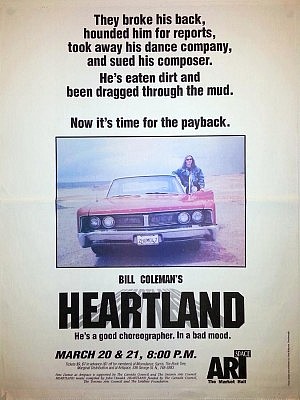
As the poster said, “He’s a good choreographer. In a bad mood.” But, like Bilbo’s ring, after that Bill Coleman’s funny side seemed lost and almost forgotten.
But something stirred in Peterborough last year; a town that historically has shared many of Coleman’s onstage jokes. Coleman, in residence with Public Energy at the Market Hall in January 2015, started pulling his pants down, choreographically speaking, once again, for the benefit of onlookers.
A ripple of curiosity ran throughout the dance community, spurring bookings in a proposed new solo work called Dollhouse. He’s tap dancing with mousetraps, knocking over ladders, stepping in buckets, and breaking crockery.
Was funny back? Could Coleman shrug off years of kinetic seriousness? Would 21st-century audiences want to see him pull his pants down? Although the verdict is not quite in — as Dollhouse premieres in April — the answer is, in short, yes and no.
Of course, we still want funny — and Coleman’s recent au naturel performance in the 3D film OutSideIn demonstrates audiences are still prepared to see him take his pants off — but we are going to have to pay for it this time.
Coupled with the seemingly loose and charming personality that greets us at the beginning of this new solo work, is an invitation to join the choreographer on a voyage of sufferance.
Some of which you can’t help laughing at, but for much of it Coleman delicately draws audiences in to share with us the surprising fortitude that accompanies us throughout life’s challenges.
All the while gently reminding us that living can be painfully funny.






















